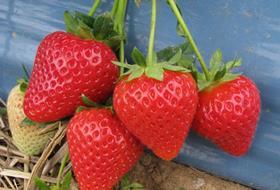
An “unprecedented” level of interest in strawberry variety Malling Centenary means growers may struggle to source enough plants for the 2016 berry season.
Bred by East Malling Research (EMR), Centenary has been promoted as a replacement for standard Junebearer Elsanta. It was released to Sainsbury’s suppliers in 2013, and became available to the wider industry this year.
“Malling Centenary is enjoying an unprecedented level of interest and is probably the fastest-growing strawberry variety, in terms of plant sales, that Meiosis has handled,” said CEO of head licensor Meiosis, Mark Coxeter. “When demand is so high, as with Centenary, growers who have worked closely with propagators are mostly likely to get the numbers of plants required.”
Jeremy Darby, berry crops adviser, said the largest Centenary plants are likely to have been sold by now, but there will be enough smaller plants available.
“As the season progressed, more and more people realised it is a variety they should be growing. It’s fair to say it has exceeded expectations,” he added.
MD of propagator RW Walpole, Paul Walpole, said: “We still have Centenary plants for sale, although they won’t be the biggest. It will replace Elsanta and Sonata really quickly, it’s setting new standards for eating quality.”
Jamie Petchell, co-founder of Global Plant Genetics, said he “wouldn’t be at all surprised” if Centenary was short. “Nurseries have taken a slower approach to multiplication of it, after having their fingers burnt in the past when producing new varieties. In berries there is often a trade-off between sweetness and yield, but this one seems to have struck just the right balance.”
One grower confirmed orders in May, but believes others will struggle. Sandy Booth, MD of the New Forest Fruit Company, said Centenary’s low wastage speeds up picking and saves costs. “We need to be able to reinvest in the future and Malling Centenary allows us to do that,” he said. Booth has secured enough plants for 25 to 30 hectares for the 2016 season, up from four hectares this year.



